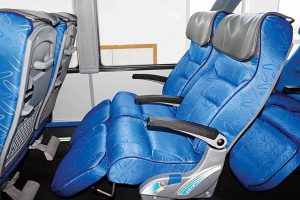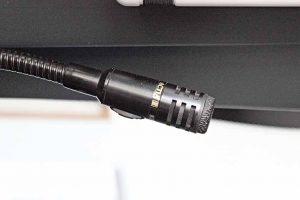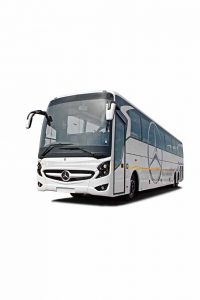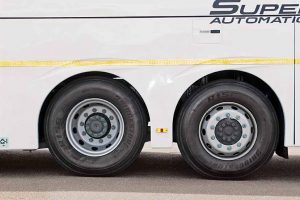Daimler India has unveiled a new Mercedes-Benz 2441 SHD luxury coach.
Story & Photos:
Ashish Bhatia
The luxury coach market is India is estimated to be in the region of 600 to 1000 units. Leading the market is Volvo Buses. After trying its hand at penetrating the market, Scania is claimed to have shut down its plant on the outskirts of Bangalore and returned home. In such a scenario is it brave of Daimler India to unveil an upgraded Mercedes-Benz SHD coach, which it builds at its plant on the outskirts of Chennai. The original SHD coach appeared a decade ago with the body built by Sutlej. Scania was not there then, and the Mercedes-Benz coach went on to compete with the Volvo coach. The numbers then were even less than that of today. Volvo had a front runner advantage, but the star found a calling. It took off to a good start. As Daimler set up its own commercial vehicle business in India and set up a plant dedicated to the manufacture of trucks and buses on the outskirts of Chennai, the Mercedes-Benz Actros and coach chassis assembly operations shifted from the Mercedes-Benz plant at Pune to Chennai. By the time the operation shifted, Daimler was building the coach bodies in India. This was done in the interest of higher quality and customer satisfaction.
The quest behind the introduction of an upgraded Mercedes-Benz SHD coach is to offer high quality and customer satisfaction.
 The new 15 m long Mercedes-Benz 2441 SHD coach replaces the Mercedes-Benz 2436 SHD coach being offered since 2015. The 12-litre six-cylinder OM457 BSIV diesel engine of the 2441 SHD produces 50 hp more than the engine of the 2436 SHD ever did. Producing 408 hp at 2000 rpm and peak torque of 1900 Nm at 1100 rpm, the engine is mated to a six-speed ZF Ecolife 6 AP 2000B automatic transmission fitted with an Intarder. Assuring higher fuel efficiency and quieter operation, the engine is located at the rear. Setting a benchmark in terms of Total Cost of Ownership (TCO), safety and comfort according to Thomas Fricke, Managing Director, Daimler Buses India, the 2441 SHD coach signals not just the determination of the company to tap the growth potential of the segment however small it may be, but also reflect on the growth potential of the premium bus segment.
The new 15 m long Mercedes-Benz 2441 SHD coach replaces the Mercedes-Benz 2436 SHD coach being offered since 2015. The 12-litre six-cylinder OM457 BSIV diesel engine of the 2441 SHD produces 50 hp more than the engine of the 2436 SHD ever did. Producing 408 hp at 2000 rpm and peak torque of 1900 Nm at 1100 rpm, the engine is mated to a six-speed ZF Ecolife 6 AP 2000B automatic transmission fitted with an Intarder. Assuring higher fuel efficiency and quieter operation, the engine is located at the rear. Setting a benchmark in terms of Total Cost of Ownership (TCO), safety and comfort according to Thomas Fricke, Managing Director, Daimler Buses India, the 2441 SHD coach signals not just the determination of the company to tap the growth potential of the segment however small it may be, but also reflect on the growth potential of the premium bus segment.
 The inability of operators to achieve a faster Return on Investment (ROI) as compared to buses in the volume segment is said to be the biggest challenge as far as the growth of premium luxury coach segment in India is concerned. It is especially the varying rules and taxation structures in each state that are said to be one of the prime hurdles with occupancy levels seldom going beyond 60 per cent. The efforts that Daimler India has taken to unveil the 2441 SHD are by no means less important therefore. Stressing upon India as a key market, Fricke expressed that the company is looking to lead the transformation in the bus segment. “At Daimler, we hold a positive outlook over the long-term,” he said.
The inability of operators to achieve a faster Return on Investment (ROI) as compared to buses in the volume segment is said to be the biggest challenge as far as the growth of premium luxury coach segment in India is concerned. It is especially the varying rules and taxation structures in each state that are said to be one of the prime hurdles with occupancy levels seldom going beyond 60 per cent. The efforts that Daimler India has taken to unveil the 2441 SHD are by no means less important therefore. Stressing upon India as a key market, Fricke expressed that the company is looking to lead the transformation in the bus segment. “At Daimler, we hold a positive outlook over the long-term,” he said.
 Over the outgoing SHD 2436 coach, the 2441 SHD coach does not look very different. It may, in fact be tough to differentiate the 2441 SHD coach from the 2436 SHD when parked besides each other. The two look the same! Retaining the premium look of the 2436 SHD coach thus, the 2441 SHD coach also makes extensive use of aluminium in its construction. Daimler calls it ‘Aluminique’ while the understructure is made of mild steel and an aluminium alloy extrusion frame, aluminium alloy sheets that make up the exterior surface of the coach are stretched and glued. The floor uses marine grade plywood and anti-skid vinyl. The weight saving resulting from judicious use of light weight material is said to contribute to superior fuel efficiency the new coach promises. Meeting global standards of performance and safety, the 2441 SHD coach capable of seating 59 people in comfortable pushback seats. Offering 14 cu. m. of luggage space with an opening height of 0.9 m, the of the coach is fuel tank is strategically positioned over the rear axle. A thermostat based fire detection system in the engine compartment is standard.
Over the outgoing SHD 2436 coach, the 2441 SHD coach does not look very different. It may, in fact be tough to differentiate the 2441 SHD coach from the 2436 SHD when parked besides each other. The two look the same! Retaining the premium look of the 2436 SHD coach thus, the 2441 SHD coach also makes extensive use of aluminium in its construction. Daimler calls it ‘Aluminique’ while the understructure is made of mild steel and an aluminium alloy extrusion frame, aluminium alloy sheets that make up the exterior surface of the coach are stretched and glued. The floor uses marine grade plywood and anti-skid vinyl. The weight saving resulting from judicious use of light weight material is said to contribute to superior fuel efficiency the new coach promises. Meeting global standards of performance and safety, the 2441 SHD coach capable of seating 59 people in comfortable pushback seats. Offering 14 cu. m. of luggage space with an opening height of 0.9 m, the of the coach is fuel tank is strategically positioned over the rear axle. A thermostat based fire detection system in the engine compartment is standard.
Flaunting an all-new dashboard, in-swing pneumatic door, and toughened glasses with a green tint, the three-axle 2441 SHD coach exceeds standard safety requirements according to Fricke. “The coach has breakable window panes, emergency exit door, and roof hatches,” he added. The safety features onboard the coach include safety belts on all seats. Anti-roll bars, and an Electronically Controlled Air Suspension (ECAS) makes for plush ride and superior stability. The ECAS system has been borrowed from Brazil, and suitably tweaked to operate in Indian conditions. Averred Fricke, that the coach was subjected to 50,000 km of rough road test. He mentioned that the banana beam structure and the positioning of air bellows near the side walls enables the bus to absorb and dampen road shocks effectively. The Electronic Braking System (EBS) of the 2441 SHD coach is made up of disc brakes, and an Anti-lock Braking System (ABS) and an Anti-Slip Regulation (ASR) system. Estimated to priced at Rs.1.2 crores approximately depending on what the customer demands, the 2441 SHD is set to enter the market that is no less competitive or electronically dormant. Riding on its company’s good performance in 2017 by recording a 80 per cent growth by selling 906 buses in comparison to the sale of 501 units in 2016, the 2441 SHD coach adds to a multi-product strategy. Daimler Buses India is already offering 10 m fully-built buses for staff, tourist and school segments. It recently introduced a 12 m front-engine bus chassis for the inter-city volume market.
The company is not leaving any stone unturned to keep up the growth momentum. Achieving remarkable growth in second year of operation despite an 18 per cent dip in the market due to the implementation of structural reforms according to Fricke, the company is betting big on the new 15 metre luxury coach. The 2441 SHD coach will present the company an opportunity to be in the premium luxury segment as well as expand the reach in the volume segments. Also concentrating on exports, Daimler Buses India has built a capacity to make 3000 bus chassis at Chennai. Targeting a
 24 per cent share of the Indian bus market (30 per cent of the 24-tonne premium bus segment), the company is looking at a domestic to export ratio of 2:3. It was 2:1 in 2017. Stating that they want to steer clear of a price war, Fricke said that emphasis would be on low TCO. Looking at doing 200 units of 2441 SHD coach this year, the bus maker is looking at moving up to BSVI emission norms before it launches any new product. Concluded Fricke, “We are confident of sustainable growth. Our two-brand strategy – BharatBenz for volume segment and Mercedes-Benz for premium segment, is working well for us.”
24 per cent share of the Indian bus market (30 per cent of the 24-tonne premium bus segment), the company is looking at a domestic to export ratio of 2:3. It was 2:1 in 2017. Stating that they want to steer clear of a price war, Fricke said that emphasis would be on low TCO. Looking at doing 200 units of 2441 SHD coach this year, the bus maker is looking at moving up to BSVI emission norms before it launches any new product. Concluded Fricke, “We are confident of sustainable growth. Our two-brand strategy – BharatBenz for volume segment and Mercedes-Benz for premium segment, is working well for us.”
Thomas Fricke, Managing Director, Daimler Buses India
 Q. How does India fare as a bus market for Daimler?
Q. How does India fare as a bus market for Daimler?
A. Europe is by far the largest market for us as it amounts to a big chunk of the Euro 4.4 billion global bus market. We sell integral buses in Europe. I think India is also on the way to evolve in a similar manner. In case of China, one needs a local presence in the market to grow.
Q. What was the motive behind upgrading the Mercedes-Benz SHD coach?
A. The entire exercise was a result of the change in emission norms to BSIV. The exercise was also a result of customer feedback received on the earlier model. We used the feedback to bring out the new SHD luxury coach, which though not very different in appearance is much improved. We avoided the two-axle configuration as it is known to affect the total cost of ownership.
Q. To whom have you sold the first six units of the upgraded SHD coach?
A. We have sold them to Parveen Travels.
Q. Is the demand for the 24-tonne premium coach segment cyclical?
A. The premium coach segment is fairly stable and less volatile. The overall dip in the bus market in India in 2017 did not impact the segment negatively.
Q. Any new technologies that you are looking to introduce in your buses?
A. Everything pertaining to the AIS140 regulation will be very important. It opens the door for advanced GPS, infotainment, telematics, etc. It’s already commercialised in Europe, and opens many doors for us in India. The only question is how easily can the technology be transferred to India, and in the Indian context.
Q. Would you look at entering the sleeper coach segment in India?
A. As an OEM we believe that it would not be sensible for us to offer sleeper coaches. If the customer wants a sleeper coach, he can build one on a chassis offered by us.
Q. What do you think of fully-built buses increasingly offered by OEMs?
A. Much depends on how the legislation plays out. With work on the bus-body code taking place, there’s definitely room for growth for fully-built buses. It is a matter of what direction the movement takes place. While support from legislation is necessary, business volume at the moment is from the sale of chassis rather than a fully-built bus. Considering the direction in which the market is currently moving, we are poised to cater to a full variety of customer needs in India.
Q. For India, are you looking at any bus brand beyond BharatBenz and Mercedes-Benz?
A. We will continue with our two brand strategy. BharatBenz will cater to the volume segment, and Mercedes-Benz will cater to the premium segment.
Q. How competitive is the Indian bus market?
A. It is quite competitive. Our study of the competitive landscape revealed that OEMs are approaching a niche segment with little or no product diversification. For operators to operate a vehicle it is imperative that the manufacturers meet the conditions. To work with a low number of vehicles in India is not feasible. The dealers can’t perform. This is exactly the reason why an entire portfolio of buses is important to us. We have a full range to be able to grow the network. We have also invested a good deal in training.
Assembly tech
The Daimler Buses India plant at Chennai is flexible in nature. The various manufacturing stages at the plant include a weld shop, frame integration station, and powder coating and chassis assembly facilities respectively. A standard toolkit is found in all areas of assembly.
 It is used across models at the same work station. With an area of 7705 sq. m., the plant has a capacity to build 1200 units of the SHD 2441 modular chassis. The overall area of bus manufacture is 12,201 sq. m., and includes the body building plant as well. Building nine-tonne bus and SHD coach, the planned capacity is of 1500 units of the nine-tonne bus and 120 units of the SHD coach. At the bus-body building facility, there are stringent quality flow systems in place. Each module goes through rust prevention.
It is used across models at the same work station. With an area of 7705 sq. m., the plant has a capacity to build 1200 units of the SHD 2441 modular chassis. The overall area of bus manufacture is 12,201 sq. m., and includes the body building plant as well. Building nine-tonne bus and SHD coach, the planned capacity is of 1500 units of the nine-tonne bus and 120 units of the SHD coach. At the bus-body building facility, there are stringent quality flow systems in place. Each module goes through rust prevention.
 After going through the paint shop (three stage process), the ready frame is put on the assembly line where the chassis is assembled. The SHD coach body line has five assembly stations whereas the nine-tonne bus body assembly has 13 stations. Once the chassis is assembled, it is rolled out to the bus body building plant. It goes to the body building side with box sections built into the chassis. With the box sections in place, the chassis now measures roughly 15 m in length. The aluminique body is built and the trim, seats, glasses and other bits including the body skin are added. The company uses a fish-bone assembly model.
After going through the paint shop (three stage process), the ready frame is put on the assembly line where the chassis is assembled. The SHD coach body line has five assembly stations whereas the nine-tonne bus body assembly has 13 stations. Once the chassis is assembled, it is rolled out to the bus body building plant. It goes to the body building side with box sections built into the chassis. With the box sections in place, the chassis now measures roughly 15 m in length. The aluminique body is built and the trim, seats, glasses and other bits including the body skin are added. The company uses a fish-bone assembly model.



























